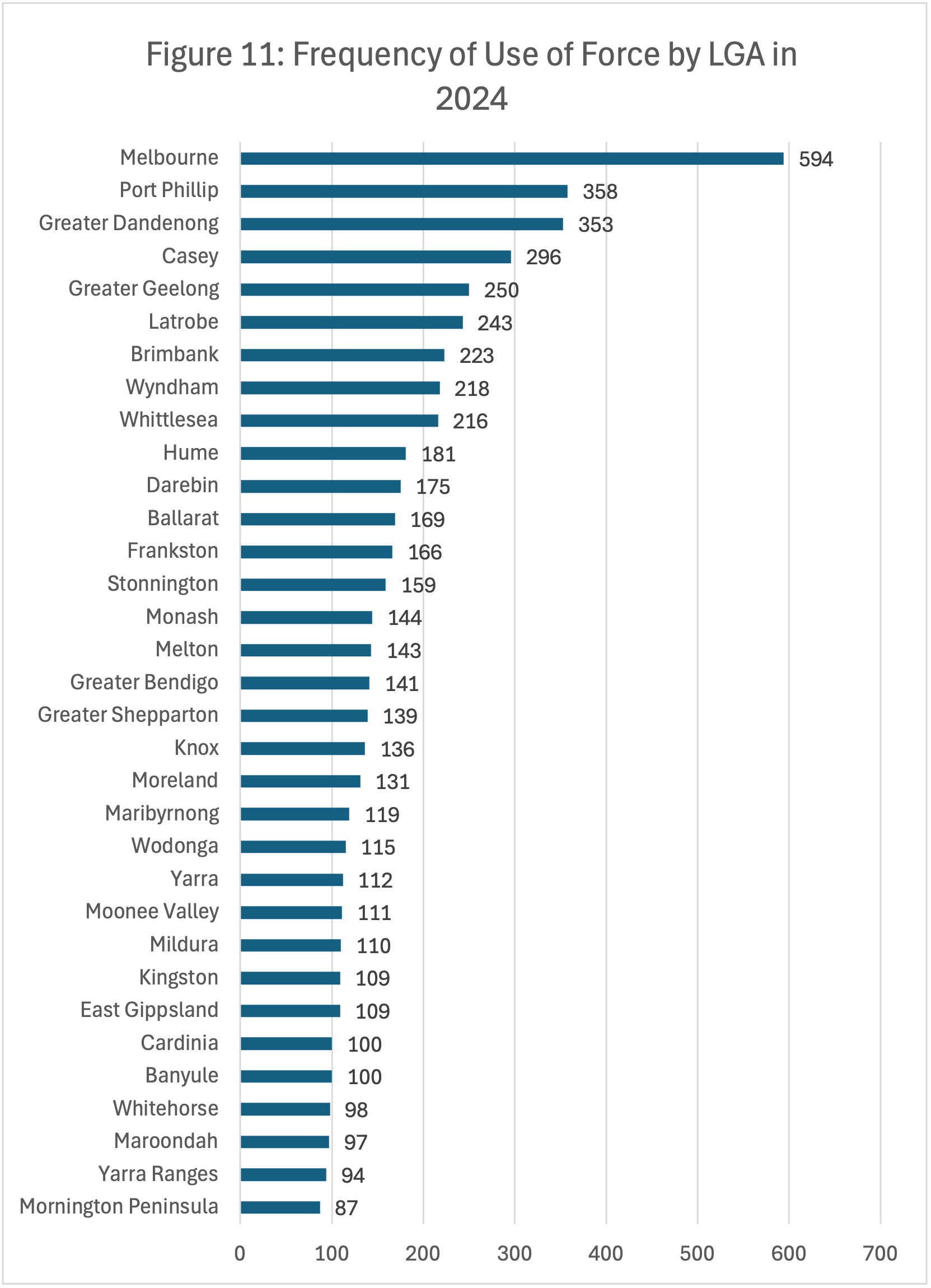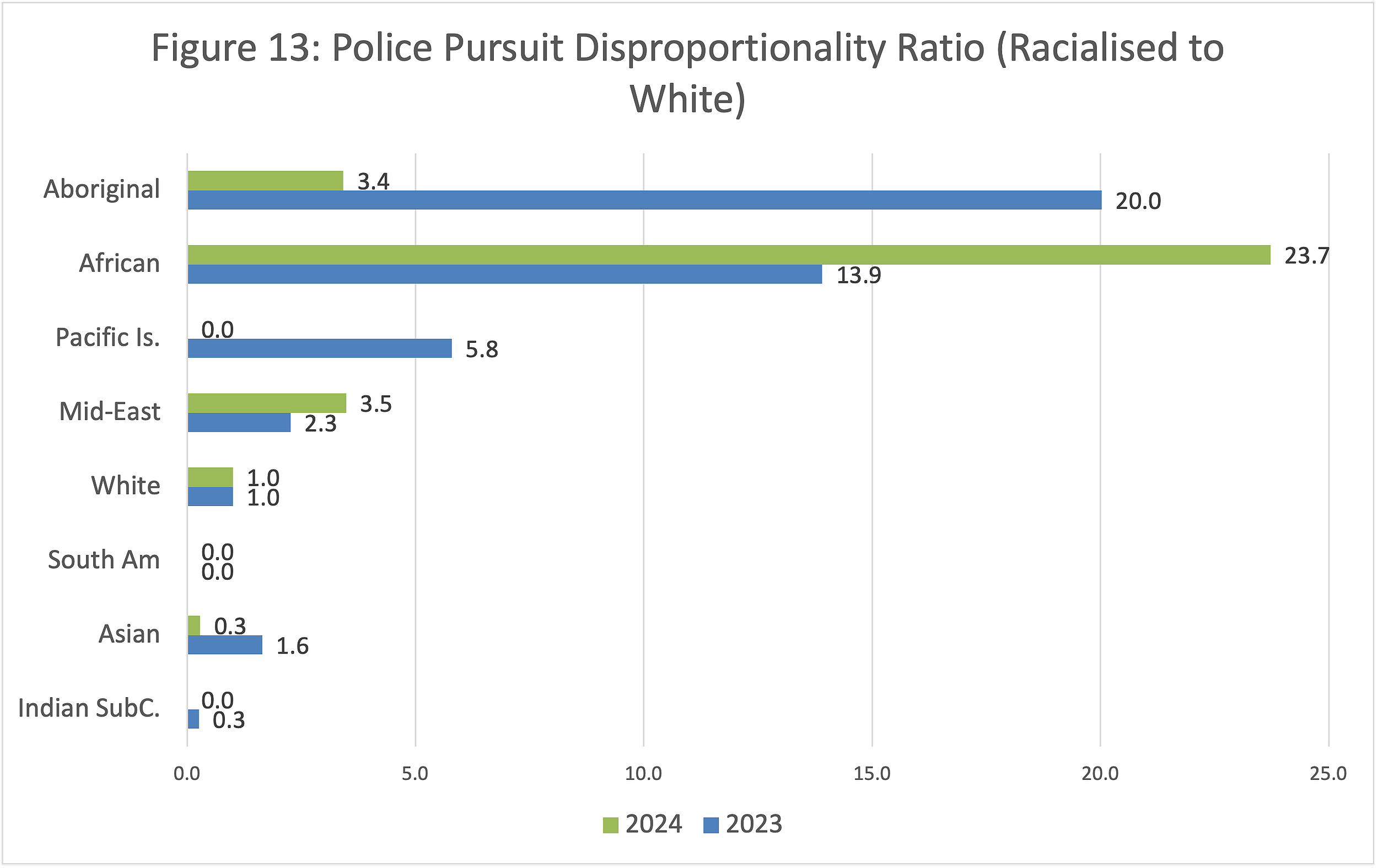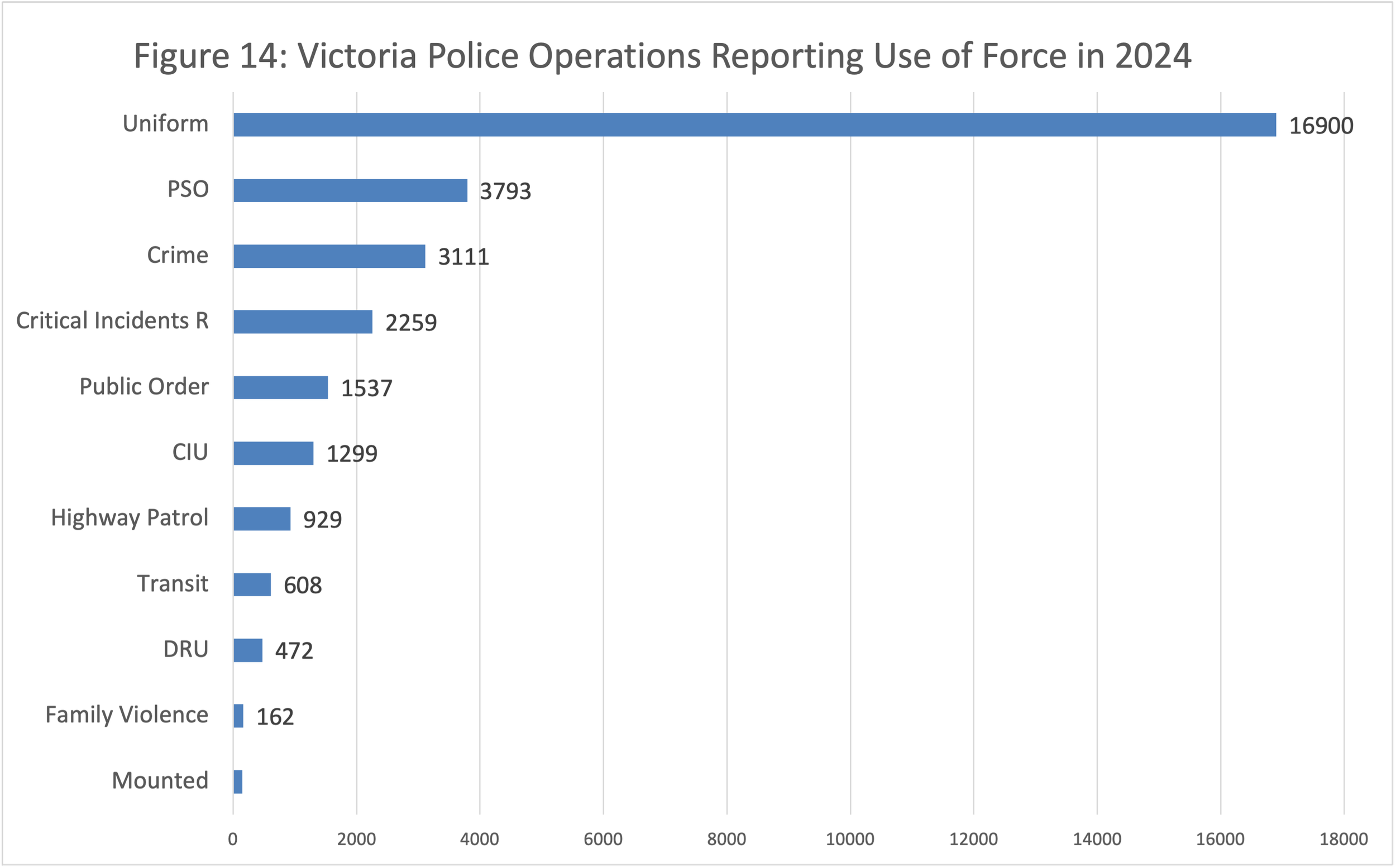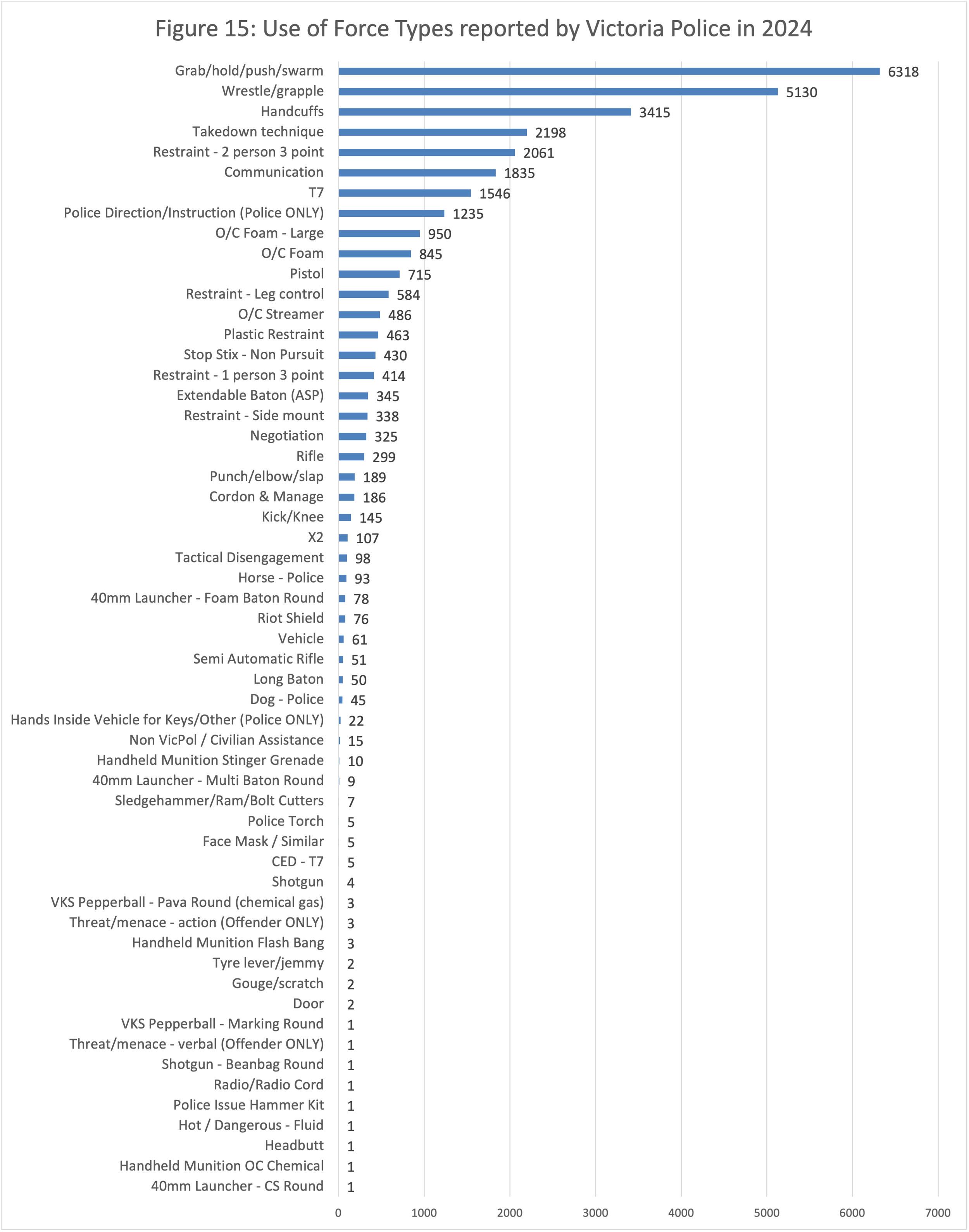Use of Force by Victoria Police
The excessive and sometimes lethal use of force against Aboriginal people and other racialised minorities has long been an issue of concern for communities in Australia. The data we gather here enables us to track just how differently the rate of police force is against racialised communities compared to White people. Every time a Victoria Police officer uses or threatens to use force, they are required to complete a Use of Force form. We know from cases litigated in courts that they do not always complete Use of Force forms. Consequently, the data Victoria Police have provided to us under FOI is limited in that it may not include all instances when force was used or threatened. One of the variables Victoria Police members are required to complete is ‘ethnic appearance’. In 2024, 12.5% of Use of Force records completed for each individual against whom force was used, was missing the police perception of that individual’s ethnic appearance. This is a better rate that for search forms (missing 17%), but still indicates that Victoria Police are not treating completing ethnic appearance as a mandatory variable on their forms.
Which racialised groups are Victoria Police more likely to use force against?
In this section we compare the number of times the police completed a use of force form for each racial appearance group against the total populations of those groups as identified in the 2021 census. This generates a use of force rate. We then compare that to the rate Victoria Police uses force against White people (compared to their size in the population). This gives us a racialised to white use of force disproportionality ratio. The rate for white people is set at 1.
Click here for information on how the census benchmark is calculated. This analysis uses Assumption 1.
Figure 10 provides evidence that in 2024 Aboriginal and Torres Strait Islander Victorians are approximately 10 times more likely to have force used against them than White people. In 2024 people who police perceive to be African are 7.2 times more likely to have force used against them than White people. People who police perceive to be Pacific Islander are 5.3 times more likely to have force used or threatened against them than White people, and people who are perceived by police to be Middle-Eastern are 2.3 times more likely to have forced used or threatened against them than White people. These findings support long held concerns by these groups that they are being policed more brutally than the White majority. The preliminary evidence is that people perceived to be Asian, Indian and South American are less likely than White people to have force used against them in 2023 and 2024. All the data used to calculate Figures 10, 12, 13, 14 and 15 is available here.
Where did Victoria Police use most force in 2024?
Who did Victoria Police Use Tasers Against?
Victoria Police complete a use of force form whenever they used a taser in the following ways: Draw/Cover/Laser Display, Drive Stun, Probe Deployment and Warning Arc. In 2024, Police were 13.3 times more likely to use or threaten to use a taser against a person they perceived to be Aboriginal than a person they perceived to be White. They were 6.1 times more likely to use a taser against a person they perceived to be African than White, and 5.9 times more likely to use a taser against a person they perceived to be Pacific Islander. VPM Taser Policy can be accessed here.
Who did Victoria Police initiate pursuits against?
The numbers of recorded pursuits where racial appearance is noted is very low: 78 in 2023 and 44 in 2024. About 1 in 3 pursuits recorded by Victoria Police do not record ethnicity. This may be because the police didn’t actually view the driver in 33% of cases. The small number of cases means that results are likely to fluctuate from year to year. However, we can see that, where police do perceive a person’s ethnicity, on average over two years worth of data, pursuits are more likely to be initiated against people the police perceive to be Aboriginal, African, Pacific Islander and Middle-Eastern than White.
Which Victoria Police Operation Types reported the most use of force?
In 2024, the Uniform branches used force at greater rate than any other operational type. The Critical Incidents Response Team is a single unit. It engaged in the most use of force of any Victoria Police unit. Family Violence units were among the groups with the lowest use of force. This lends weight to the calls of Beyond Survival at Flat Out for a civilian rather than police response to the majority of family violence incidents. Please note, in Figure 14 and Figure 15 more than one police officer may be using force or exercising a tactic against an individual.
What force types did Victoria Police Use In 2024?
Discussion
This data reveals that people police perceive to be Aboriginal, African, Middle Eastern and Pacific Islander are more likely to be subjected to the use of force than is expected from their respective proportions in the population. This disproportionality is indicative of systemic racism against these populations. Police do not use force equally across all Victorians, but disproportionately against First Nations and particular racialised groups. Importantly, these are the same groups that are subjected to higher levels of searching by the police. The increased rate of stop, investigation, questioning and search of these groups is likely to be behind the higher use of force against these groups. Another factor behind the increased use of force against these groups is likely to be an unjustified stereotype by police about the dangerousness of people perceived to be from these groups. There are many cases in Victoria of First Nations and other racialised Victorians being subject to force by police without justification (see for eg. Yoorrook Justice Commission, Gebrehiwot v State of Victoria, God & Koua v Grey & Ors, Matiang & Ors v Fox & Ors, Dini v State of Victoria).
In 2024 the police data paints a clear picture. When compared with people perceived to be White, people perceived to be Aboriginal and Torres Strait Islanders are 10 times more likely to have force used against them and 13 times more likely to have tasers used against them than White people. Aboriginal women are 10.6 times more likely to have force used against them than White women. People the police perceive to be African are 7 times more likely to have force used against them and 6 times more likely to have tasers used against them than White people. African woman are 4.3 times more likely to have force used against them than White women. People the police believe to be Pacific Islander are 5 times more likely that White people to have force used against them and are 6 times more likely to have a taser used against them. Pacific Islander women are 5.4 times more likely to have force used against them than White women. People who police perceive to be Middle-Eastern are twice as likely as White people to have force used against them and twice as likely as White people to have a taser used on them. Each of these groups was, on average, more likely to have a pursuit initiated against them than white people. People perceived to be Asian, South American or from the Indian sub-continent are less likely to have all forms of force used against them than White people. These are also the groups that are less likely to be searched by Victoria Police.
A census benchmarking analysis of use of force data from Victoria Police reveals systemic racism toward (that is the disproportionate over-use of force against) all non-White groups, except Asians, South Americans and Indians.








